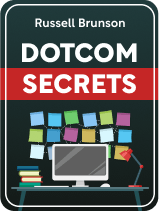

This article is an excerpt from the Shortform book guide to "Dotcom Secrets" by Russell Brunson. Shortform has the world's best summaries and analyses of books you should be reading.
Like this article? Sign up for a free trial here.
What is Russel Brunson’s Dotcom Secrets about? What is the key message to take away from the book?
In his book Dotcom Secrets, Russel Brunson presents the science of building high-converting sales funnels for any business. You’ll learn why sales funnels are superior to regular websites when it comes to converting customers, what an effective sales funnel looks like, and how to build one for your business.
Below is a brief overview of Dotcom Secrets by Russel Brunson.
Dotcom Secrets
The internet is full of online businesses, but what separates the million-dollar startups from the unprofitable failures? In his book Dotcom Secrets, Russel Brunson argues that the answer is sales funnels: website layouts that create sales by guiding customers through a preset experience. This experience persuades them of your product’s value every step of the way.
Dotcom Secrets is the first book in Brunson’s “Secrets Trilogy,” which also includes Expert Secrets, a guide to creating an engaging and inspiring brand image, and Traffic Secrets, a guide to attracting customers to your website. Brunson is also the co-founder of ClickFunnels, an all-in-one online marketing tool that helps you build a website, test and improve your sales funnels, and more.
We’ll begin this guide with an overview of Brunson’s big-picture strategy: why and how to use sales funnels to maximize your profits. Then, we’ll walk chronologically through the process of starting an online business, discussing how to use direct marketing to gather leads, how to design a profitable sales funnel, and how to expand your business after you’ve built your first sales funnel.
In our commentary, we’ll help you put Brunson’s ideas into action by offering complementary ideas from marketing books like Permission Marketing and Jab, Jab, Jab, Right Hook, as well as books for startup entrepreneurs like The Lean Startup and The Mom Test.
Big-Picture Strategy: How to Maximize Profits With Sales Funnels
According to Brunson, high-quality sales funnels are the key to a successful online business for two main reasons.
Reason #1: Sales Funnels Convert Visitors Into Customers
Brunson contends that sales funnels are the most effective way to convert visitors to your website into paying customers. To explain why, let’s contrast funnels with an ordinary business website.
Most websites look like a menu of options: A customer can click to different pages depending on what they’re looking for. However, Brunson argues that this layout is really bad at attracting new customers because complicated websites with a multitude of menu options are confusing and difficult to navigate, even if people already know what they want to buy from you. Unfortunately, when your website confuses your visitors, they’re more likely to leave than put in the hard work necessary to figure things out.
On the other hand, when your website is a sales funnel, you avoid presenting a confusing menu of options. Instead, you show all new visitors the same message about your product and give them one place to click if they’re interested in moving forward. They then enter a series of pages persuading them to make a purchase, each of which links to the next one and nowhere else. This structure prevents visitors to your website from getting lost or confused, and it presents them with a single refined and persuasive message, maximizing the chance they’ll become customers.
Brunson explains that each kind of product you sell requires a different sales funnel on your website—the path on your website that convinces customers to buy a book will look very different from the one selling access to an overseas retreat. We’ll go into more depth on what a sales funnel should look like later in this guide.
Reason #2: Sales Funnels Get Each Customer to Spend More
Ideally, your sales funnels do more than turn website traffic into paying customers. They also get each customer to purchase more than they otherwise would have by getting them to spend more at one time and encouraging them to return and buy again in the future.
Getting each customer to buy more is the secret to business growth, according to Brunson: Every new customer costs significant marketing expenses to acquire, but getting each customer to spend more gives you more revenue at no additional marketing expense, resulting in vastly more profit. These massive profits then allow you to spend more on marketing, creating a virtuous cycle in which every sale you make funds the acquisition of the next several sales. This empowers you to grow your business exponentially and dominate the market.
In contrast, most online businesses fail to achieve this virtuous cycle. Often, when businesses aren’t getting as much website traffic as they want, they make the mistake of trying to improve their marketing so more potential customers click through to the website. If they instead improved their sales funnels so each customer spent more, they could increase traffic to their website through heavier investment in marketing.
How Sales Funnels Maximize Profits
How do sales funnels get each customer to spend more money? To explain, let’s take a look at the broader business strategy you’ll be using.
Brunson suggests that every business should offer a range of products at varying price points: some that are free or nearly free, some that are moderately priced, and others that are far more expensive than you expect customers to be willing to pay. This is beneficial for a couple of reasons. First, it allows you to acquire customers of any budget, ensuring that you serve as many people as possible.
Second, Brunson explains that once you have a wide range of products to offer your customers, you can use sales funnels to persuade them to purchase increasingly valuable products over time. Customers who try your products and benefit from them firsthand are far more willing to trust you than new customers. Thus, they’re willing to make greater investments in your more expensive offerings.
For example, if you start a business that helps people learn how to travel the world, you could offer a free ebook of travel tips, a $20 physical book of more comprehensive travel tips, a $300 personal travel planning session over video call, and a $3000 registration for an overseas retreat with hands-on coaching. Ideally, you’ll gain customers who are drawn in by your free ebook, then buy and enjoy your physical book, invest in a travel planning session or two, and finally buy a ticket to your retreat. You only need a few customers to escalate to the highest tier for you to start making significant profits.
In addition to this broader strategy, sales funnels get each customer to spend more every time they make a purchase by selling add-ons in the middle of the purchase process, which are easy to buy impulsively. We’ll cover this in more detail later.
How to Build an Audience of Leads
So far, we’ve established Brunson’s recommended big-picture business strategy: Use multiple pricing tiers to attract customers and move them into more expensive sales funnels. Now, we’ll dive deeper into the specifics of how to do this, starting with advice for direct marketing. In a sense, this is your first sales funnel, even though it doesn’t cost your customers anything. Like your other sales funnels, it’s a preset path that gets customers to invest more in your product—although at this stage, they’re just investing time and attention.
Brunson argues that the end goal of all your marketing is to move potential customers onto marketing channels where you can directly message them for free. Typically, this involves running paid advertisements on platforms you don’t own (usually social media platforms) that link to a page on your website persuading people to sign up for your email list. Direct communication channels like email allow you to minimize your marketing expenses and get existing customers to buy more (which, as we mentioned, is the key to business growth).
Brunson recommends creating something valuable that you can offer for free as an incentive for people to join your email list. The more valuable it is, the more likely users will be to trade their email addresses for it. For example, you could offer your free ebook of travel tips to anyone who joins your email list.
The 2 Types of Direct Communication
Once prospects have signed up for your email list, Brunson recommends sending them two types of direct communication, each of which engages a different kind of customer in hopes of moving them to another sales funnel.
Type #1: Immediate Sell
When potential customers sign up for your email list, you’ll want to convert them into paying customers as soon as possible. Brunson recommends sending a series of emails that get your audience to emotionally connect with your brand.
To do this, tell the personal story of how you established your brand and explain the personal relationship you want your business to have with its customers. Customers will value your business more if they see you as a real, relatable human. For example, perhaps you had a study abroad experience in college that changed your life and motivated you to live nomadically around the world for 20 years. Now, you want to sell the expert travel knowledge you picked up over the years to help others broaden their minds and change their lives.
Reveal these story details in a series of emails over the course of several days to deepen readers’ long-term interest. Furthermore, provide links to one of your sales funnels throughout the email chain, so if a reader ever feels sufficiently inspired to invest in you, they know what to do next.
Type #2: Ongoing Engagement
Sometimes, despite your attempts to spur potential customers into action, they won’t be ready to make an immediate investment. In this case, Brunson explains that your goal becomes keeping a channel of communication open until they’re ready to buy something. Send regular emails that entertain or provide consistent value to your readers while simultaneously linking interested customers to your sales funnels. These ongoing emails are also a way to push previous customers to make further purchases.
Brunson recommends messaging your email list every day. Every email you send will lead to purchases, so any time you skip a day, you’re losing sales. You may worry that sending too many emails will push readers to unsubscribe, but if your emails are truly entertaining or useful (or both), people will be glad to receive them.
How to Create an Effective Sales Funnel
We’ve covered how to set up your first sales funnel, a line of direct communication to anyone interested in your product. Now, let’s explain how to make your real sales funnels—the ones that convince customers to make a purchase—as compelling as possible.
We’ll start by explaining the three fundamentals that give your sales funnels their persuasive power. Then, we’ll describe what a basic sales funnel looks like on your website, breaking it down into detailed stages. Finally, we’ll describe a notable exception to this formula to use for your most expensive products: a sales funnel that leads offline.
The Three Fundamentals of Online Sales
According to Brunson, every page in each of your sales funnels—including the aforementioned marketing emails—should persuade your audience to further invest in your product using the same three steps. First, catch your audience’s attention; then, illustrate your product’s value; and finally, cue them to act. These three fundamentals ensure that your potential customer is as excited as possible about your product and knows exactly what to do next to get it. Once you get them into the first page of your sales funnel, the fundamentals will get them to continue through each page and make a purchase at the end.
Let’s dive into each of the three fundamentals in a little more detail.
Fundamental #1: Catch the Audience’s Attention
First, Brunson states that every page in your sales funnel needs to seize the reader’s attention: Before you begin pitching your product to the audience, make sure they want to listen. Thus, every part of your sales funnel should feature a single element that’s so visible and intriguing that your reader can’t help but pay closer attention to the rest of your message. For instance, this could be a large text headline or a striking image.
There’s no need to describe any specifics about your product during this step. Rather, make it clear that you can fulfill a specific desire or solve a specific problem that your reader has. For example, if you want website visitors to enter their email addresses in exchange for a free ebook of travel tips, catch readers’ attention with a large headline that reads “Learn how to spend six months overseas for less than $1000!”
Fundamental #2: Illustrate Your Product’s Value With Stories
Second, every part of your sales funnel should tell stories that show why your product is uniquely valuable. We touched on this when discussing direct email marketing—by describing your and your business’s unique backstory, you emphasize how you differ from your competitors and offer value that customers can’t get anywhere else.
Specifically, Brunson suggests using anecdotes to convey details about your product. Grounded, easily understandable stories that illustrate a single point are the most memorable form your messages can take. For example, if you’re offering a free travel ebook on traveling cheaply, include a couple of paragraphs describing a stranger you met overseas who spent far more money than you but had a far less enriching travel experience because they followed mainstream, tourist-centered travel advice.
Fundamental #3: Call to Action
Third, each page in your sales funnel should tell the potential customer what to do next and what they’ll get for doing so. Brunson suggests making your call to action effective by making it so rewarding that the customer can’t possibly refuse. Specifically, he recommends making sure that the perceived value of everything you offer is far greater than what you’re charging for it. That way, you can be successful even if your products are much more expensive than those of your competitors since you’re giving that much more value in exchange.
One way to do this is by bundling together multiple valuable items or services that would each be worth paying for alone. For example, if you’re trying to get visitors to buy a case of protein bars, throw in a free ebook of weightlifting tips and access to the full archive of your fitness-themed podcast.
The Stages of a Sales Funnel
We’ve explained what each stage of your sales funnel should do—now, let’s cover what, specifically, your sales funnels should look like. This is an overview of the stages of a basic sales funnel, each of which will ideally catch the audience’s attention, illustrate your product’s value, and include a call to action. Brunson describes many specific variations of the sales funnel, but they all more or less follow this same basic structure.
Stage #1: Purchase Page
Typically, the first page in your sales funnel both persuades the customer to buy your product and provides the order form for purchasing it, according to Brunson. Catch the audience’s attention and illustrate your product’s value with a story; then, call them to action by telling them to fill out an order form on this page.
If your product is free or very cheap, make the order form visible immediately—you don’t need to work hard to convince the audience to make such a low commitment. If your product is a bit more expensive, Brunson suggests providing more stories that illustrate value and force the reader to scroll down before revealing the order form.
Stage #2: Add-On Button
The second stage of your standard sales funnel, the add-on button, is located on your purchase page. After a customer has filled in their payment information, insert a checkbox offering to add a related product to their order for an additional fee (Brunson calls this the “order form bump”). For example, when you’re buying concert tickets, you often have the option to tick a box and pay an additional fee for insurance in case an emergency causes you to miss the concert.
Add-ons like this are the main reason that sales funnels are so profitable, explains Brunson. Once someone has already committed to buying something on your website, they’ll often impulsively spend more if you give them the opportunity. This is profitable because it allows you to generate sales without spending any more on marketing, as we established earlier.
What kinds of things should you sell as add-ons? Brunson asserts that if you’re selling a physical product, the best way to generate additional sales is to offer the customer more of what they’ve already bought at a special discount. For example, if you’re selling ceramic dishes online, offer to add on a second matching set for half the price.
However, for information products like books, lessons, or workshops, you can’t sell more of the same thing, as customers often assume that once they’ve learned something from you, they won’t need any more information on the topic. Instead, identify the goal they’re trying to solve with their purchase and offer the next logical thing that they’ll need. For example, if you’re selling a book of travel tips, instead of trying to sell another book about travel, offer to add on a travel knapsack.
Stage #3: Add-On Page
After your customer clicks the “purchase” button but before you tell them that their order is complete, take them to an add-on page. This is functionally the same as an add-on button, but it takes up a whole page. You may be successful including more than one add-on page in a row—Brunson asserts that including multiple opportunities for customers to buy add-ons will vastly increase your profits.
Stage #4: Thanks Page
Once you’ve made all your add-on offers to the customer, Brunson recommends directing them to a page confirming that their order is complete and thanking them for their purchase. If possible, link to other products you have to offer so the end of one sales funnel puts them at the beginning of another. That way, the customers who are really excited about your business have the opportunity to invest as much as possible in you right away. To return to our earlier example, if a customer has just bought your book of travel advice, provide a link to the page on your site selling one-on-one travel coaching.
Offline Sales Funnels
For your most expensive products, you’ll want to create a sales funnel that eventually leads offline. You’ll have a much easier time retaining the customer’s attention and making your sales pitch as persuasive as possible if you’re selling to them on the phone or in person.
To create this offline funnel, instead of sending customers to a purchase page, Brunson recommends using an application page where potential customers can apply for access to an exclusive offer. Often, products like this will require your personal involvement, and applications help you choose which people you’d most like to work with so you can invest your time wisely.
For example, if you’re trying to register people for your overseas travel coaching retreat, create a form that lets people apply for the privilege to join, then set up phone or video calls with the customers you want to be there. Provide them with more information about the offer on these calls and work out payment details there.
After You’ve Built Your First Sales Funnel
So far, we’ve explained how sales funnels work, how to build an audience of leads, and how to design a profitable sales funnel. Last, we’ll cover what your next steps will be after your website is up and running.
Brunson explains that most sales funnels will require tweaks after you’ve launched them. Track the percentage of customers that click through each stage of your sales funnel—this is your conversion rate. If a stage is underperforming, it’s because it’s failing to accomplish one or more of the three fundamentals of online sales. Make changes until that stage successfully catches the audience’s attention, illustrates your product’s value, and provides an enticing call to action.
Continue to tweak and improve your first sales funnel until it’s yielding consistent profits. According to Brunson, there’s no reason to create a second sales funnel until your first has reached its full potential of profitability. Then, create a new product with its own sales funnel that you can link to in the thanks page of your other sales funnels and in your daily emails. Repeat this process indefinitely, creating more interconnected sales funnels and increasing your profits as much as you’d like.

———End of Preview———
Like what you just read? Read the rest of the world's best book summary and analysis of Russell Brunson's "Dotcom Secrets" at Shortform.
Here's what you'll find in our full Dotcom Secrets summary:
- What separates the million-dollar startups from the unprofitable failures
- Why your company's website should be organized as a sales funnel
- How to attract customers to your site and make a compelling marketing message






